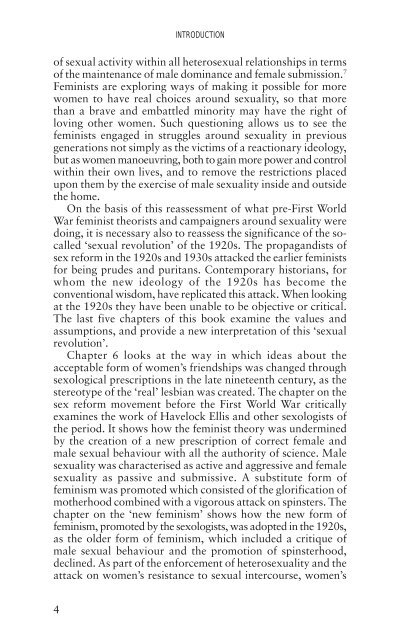The Spinster and Her Enemies - Feminish
The Spinster and Her Enemies - Feminish
The Spinster and Her Enemies - Feminish
You also want an ePaper? Increase the reach of your titles
YUMPU automatically turns print PDFs into web optimized ePapers that Google loves.
INTRODUCTION<br />
of sexual activity within all heterosexual relationships in terms<br />
of the maintenance of male dominance <strong>and</strong> female submission. 7<br />
Feminists are exploring ways of making it possible for more<br />
women to have real choices around sexuality, so that more<br />
than a brave <strong>and</strong> embattled minority may have the right of<br />
loving other women. Such questioning allows us to see the<br />
feminists engaged in struggles around sexuality in previous<br />
generations not simply as the victims of a reactionary ideology,<br />
but as women manoeuvring, both to gain more power <strong>and</strong> control<br />
within their own lives, <strong>and</strong> to remove the restrictions placed<br />
upon them by the exercise of male sexuality inside <strong>and</strong> outside<br />
the home.<br />
On the basis of this reassessment of what pre-First World<br />
War feminist theorists <strong>and</strong> campaigners around sexuality were<br />
doing, it is necessary also to reassess the significance of the socalled<br />
‘sexual revolution’ of the 1920s. <strong>The</strong> propag<strong>and</strong>ists of<br />
sex reform in the 1920s <strong>and</strong> 1930s attacked the earlier feminists<br />
for being prudes <strong>and</strong> puritans. Contemporary historians, for<br />
whom the new ideology of the 1920s has become the<br />
conventional wisdom, have replicated this attack. When looking<br />
at the 1920s they have been unable to be objective or critical.<br />
<strong>The</strong> last five chapters of this book examine the values <strong>and</strong><br />
assumptions, <strong>and</strong> provide a new interpretation of this ‘sexual<br />
revolution’.<br />
Chapter 6 looks at the way in which ideas about the<br />
acceptable form of women’s friendships was changed through<br />
sexological prescriptions in the late nineteenth century, as the<br />
stereotype of the ‘real’ lesbian was created. <strong>The</strong> chapter on the<br />
sex reform movement before the First World War critically<br />
examines the work of Havelock Ellis <strong>and</strong> other sexologists of<br />
the period. It shows how the feminist theory was undermined<br />
by the creation of a new prescription of correct female <strong>and</strong><br />
male sexual behaviour with all the authority of science. Male<br />
sexuality was characterised as active <strong>and</strong> aggressive <strong>and</strong> female<br />
sexuality as passive <strong>and</strong> submissive. A substitute form of<br />
feminism was promoted which consisted of the glorification of<br />
motherhood combined with a vigorous attack on spinsters. <strong>The</strong><br />
chapter on the ‘new feminism’ shows how the new form of<br />
feminism, promoted by the sexologists, was adopted in the 1920s,<br />
as the older form of feminism, which included a critique of<br />
male sexual behaviour <strong>and</strong> the promotion of spinsterhood,<br />
declined. As part of the enforcement of heterosexuality <strong>and</strong> the<br />
attack on women’s resistance to sexual intercourse, women’s<br />
4

















